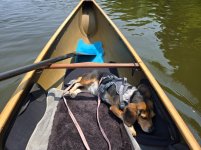I've been paddling my Seliga Tripper mostly solo so far this season. I paddle from the stern seat with some light ballast (20-25lbs.) either in the bow or right behind the bow seat. I find that adding the ballast eliminates the twitchiness in initial stability that this boat has, probably caused by the round bottom. I was surprised recently when I took a friend out fishing that the twitchiness was back, even though there was a lot more weight in the boat. Usually a boat will get more stable when you add weight, so something else must be going on. The only thing I can think that would cause this is the trim of the boat.
When paddling tandem the boat has a fairly flat trim and rides high in the water. It is probably close to the 32 inch waterline that is stated in the specs. When solo, even with significantly less weight I think the maximum waterline is much wider, probably approaching the maximum 36" width of the boat. Even though there is less wetted surface of the hull, stability increases. This could be something to experiment with if you want more stability. I was never a "flat trim" guy, preferring to be bow light. This is one more reason for a bow light trim.
When paddling tandem the boat has a fairly flat trim and rides high in the water. It is probably close to the 32 inch waterline that is stated in the specs. When solo, even with significantly less weight I think the maximum waterline is much wider, probably approaching the maximum 36" width of the boat. Even though there is less wetted surface of the hull, stability increases. This could be something to experiment with if you want more stability. I was never a "flat trim" guy, preferring to be bow light. This is one more reason for a bow light trim.

